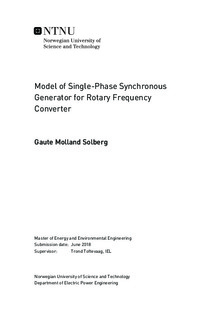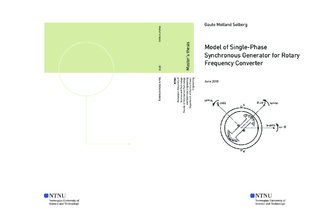| dc.contributor.advisor | Toftevaag, Trond | |
| dc.contributor.author | Solberg, Gaute Molland | |
| dc.date.accessioned | 2018-08-31T14:02:19Z | |
| dc.date.available | 2018-08-31T14:02:19Z | |
| dc.date.created | 2018-06-11 | |
| dc.date.issued | 2018 | |
| dc.identifier | ntnudaim:18974 | |
| dc.identifier.uri | http://hdl.handle.net/11250/2560379 | |
| dc.description.abstract | Synchronous-synchronous rotary frequency converters are in the Norwegian traction power system applied for converting three-phase AC voltage at 50 Hz to single-phase AC voltage at 16 2/3 Hz. The converters consist of a three-phase synchronous motor and a single-phase synchronous generator combined on a common shaft. The three-phase motor is fed from the public grid and drives the single-phase generator. The motor-to-generator number of pole ratio is three-to-one, enabling the single-phase generator to generate the voltage at a frequency one-third of that applied to the three-phase motor.
This Master's Thesis describes three approaches for modeling single-phase synchronous generators in rotary frequency converters.
Model 1 is developed by applying one armature winding combined with rotor windings identical to the three-phase machine's rotor configuration. The equations are used directly, and not transformed to a common reference frame. Test results obtained from the implemented model present a rotary converter model experiencing initial conditions that are destabilizing the converter.
Model 2 views the behavior of the armature single-phase winding's pulsating MMF distribution as the result of two fictitious three-phase machines. Each machine induces a rotating MMF distribution. Equations are developed for each machine individually. They are decoupled from each other but interacts with their common rotor circuits. Successful model implementation has not been obtained, due to the simulation not converging to final solutions.
Model 3 applies a three-phase synchronous machine with one open-circuited phase and necessary parameter adjustments for obtaining the behavior of the single-phase machine. Test results present the converter model behaving as expected during the loaded steady-state performance. The rate of decay of symmetrical fault current is faster than for sets of parameter adjustments carried out in the literature. | |
| dc.language | eng | |
| dc.publisher | NTNU | |
| dc.subject | Energi og miljø, Elektrisk energiomforming | |
| dc.title | Model of Single-Phase Synchronous Generator for Rotary Frequency Converter | |
| dc.type | Master thesis | |

